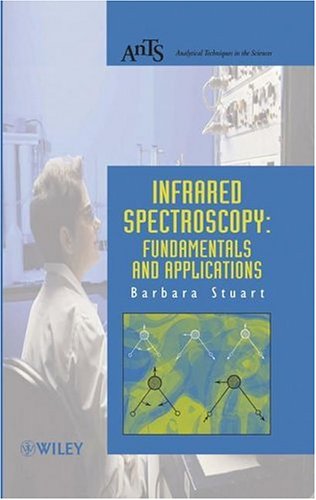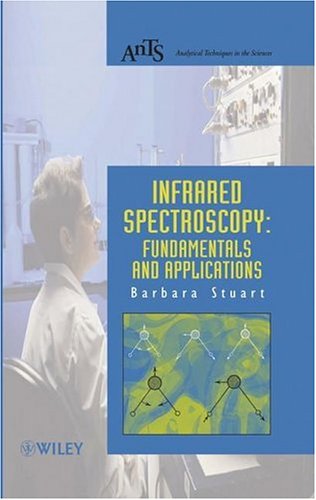Series Preface.
Preface.
Acronyms, Abbreviations and Symbols.
About the Author.
1. Introduction.
1.1 Electromagnetic Radiation.
1.2 Infrared Absorptions.
1.3 Normal Modes of Vibration.
1.4 Complicating Factors.
1.4.1 Overtone and Combination Bands.
1.4.2 Fermi Resonance.
1.4.3 Coupling.
1.4.4 Vibration–Rotation Bands.
References.
2. Experimental Methods.
2.1 Introduction.
2.2 Dispersive Infrared Spectrometers.
2.3 Fourier-Transform Infrared Spectrometers.
2.3.1 Michelson Interferometers.
2.3.2 Sources and Detectors.
2.3.3 Fourier-Transformation.
2.3.4 Moving Mirrors.
2.3.5 Signal-Averaging.
2.3.6 Advantages.
2.3.7 Computers.
2.3.8 Spectra.
2.4 Transmission Methods.
2.4.1 Liquids and Solutions.
2.4.2 Solids.
2.4.3 Gases.
2.4.4 Pathlength Calibration.
2.5 Reflectance Methods.
2.5.1 Attenuated Total Reflectance Spectroscopy.
2.5.2 Specular Reflectance Spectroscopy.
2.5.3 Diffuse Reflectance Spectroscopy.
2.5.4 Photoacoustic Spectroscopy.
2.6 Microsampling Methods.
2.7 Chromatography–Infrared Spectroscopy.
2.8 Thermal Analysis–Infrared Spectroscopy.
2.9 Other Techniques.
References.
3. Spectral Analysis.
3.1 Introduction.
3.2 Group Frequencies.
3.2.1 Mid-Infrared Region.
3.2.2 Near-Infrared Region.
3.2.3 Far-Infrared Region.
3.3 Identification.
3.4 Hydrogen Bonding.
3.5 Spectrum Manipulation.
3.5.1 Baseline Correction.
3.5.2 Smoothing.
3.5.3 Difference Spectra.
3.5.4 Derivatives.
3.5.5 Deconvolution.
3.5.6 Curve-Fitting.
3.6 Concentration.
3.7 Simple Quantitative Analysis.
3.7.1 Analysis of Liquid Samples.
3.7.2 Analysis of Solid Samples.
3.8 Multi-Component Analysis.
3.9 Calibration Methods.
References.
4. Organic Molecules.
4.1 Introduction.
4.2 Aliphatic Hydrocarbons.
4.3 Aromatic Compounds.
4.4 Oxygen-Containing Compounds.
4.4.1 Alcohols and Phenols.
4.4.2 Ethers.
4.4.3 Aldehydes and Ketones.
4.4.4 Esters.
4.4.5 Carboxylic Acids and Anhydrides.
4.5 Nitrogen-Containing Compounds.
4.5.1 Amines.
4.5.2 Amides.
4.6 Halogen-Containing Compounds.
4.7 Heterocyclic Compounds.
4.8 Boron Compounds.
4.9 Silicon Compounds.
4.10 Phosphorus Compounds.
4.11 Sulfur Compounds.
4.12 Near-Infrared Spectra.
4.13 Identification.
References.
5. Inorganic Molecules.
5.1 Introduction.
5.2 General Considerations.
5.3 Normal Modes of Vibration.
5.4 Coordination Compounds.
5.5 Isomerism.
5.6 Metal Carbonyls.
5.7 Organometallic Compounds.
5.8 Minerals.
References.
6. Polymers.
6.1 Introduction.
6.2 Identification.
6.3 Polymerization.
6.4 Structure.
6.5 Surfaces.
6.6 Degradation.
References.
7. Biological Applications.
7.1 Introduction.
7.2 Lipids.
7.3 Proteins and Peptides.
7.4 Nucleic Acids.
7.5 Disease Diagnosis.
7.6 Microbial Cells.
7.7 Plants.
7.8 Clinical Chemistry.
References.
8. Industrial and Environmental Applications.
8.1 Introduction.
8.2 Pharmaceutical Applications.
8.3 Food Science.
8.4 Agricultural Applications.
8.5 Pulp and Paper Industries.
8.6 Paint Industry.
8.7 Environmental Applications.
References.
Responses to Self-Assessment Questions.
Bibliography.
Glossary of Terms.
SI Units and Physical Constants.
Periodic Table.
Index.



